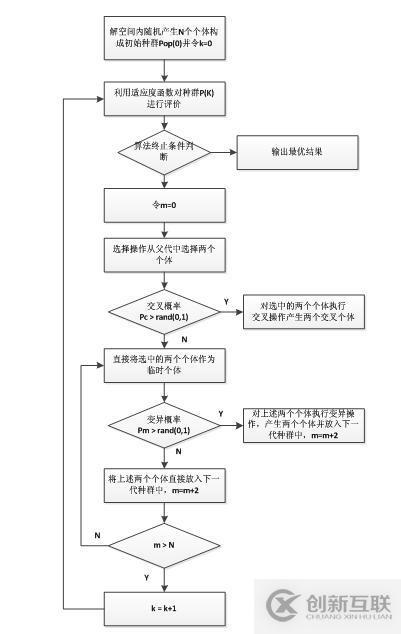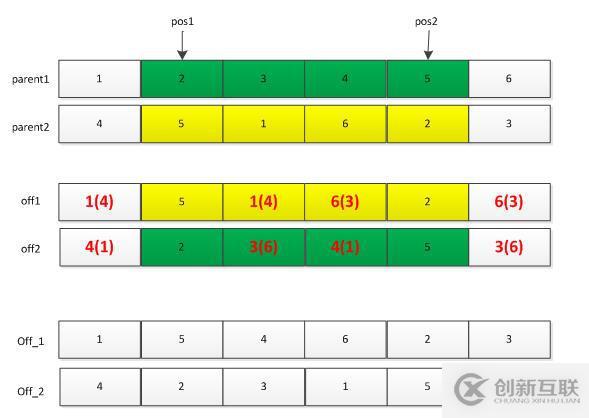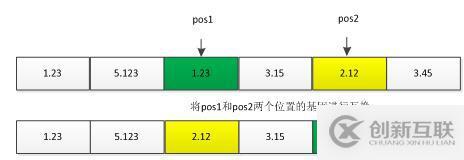python中遗传算法的示例分析-创新互联
这篇文章主要介绍了python中遗传算法的示例分析,具有一定借鉴价值,感兴趣的朋友可以参考下,希望大家阅读完这篇文章之后大有收获,下面让小编带着大家一起了解一下。

具体内容如下
1、基本概念



2、主要步骤
流程图如下所示:

3、主要操作介绍
3.1 种群初始化
n个决策变量{x1,x2,…,xn}。每个决策变量有取值范围:下界{L1,L2,…,Ln}和上界{U1,U2,…,Un},则种群中个体的初始化即随机地在决策变量的取值范围内生成各个决策变量的值:Xj={x1,x2,...,xn},其中xi属于范围(Li,Ui)内。所有的个体即构成种群。当每个个体都初始化后,即种群完成初始化。
3.2 评价种群
population有popsize个个体。依次计算每个个体的适应度值及评价种群。
3.3 选择操作
P(Xj) = fit(Xj)/(fit(X1)+fit(X2)+fit(X3)+fit(X4)),j=1,2,3,4

3.4 交叉操作

3.5 变异操作


符号变异:

4、Python代码
#-*- coding:utf-8 -*-
import random
import math
from operator import itemgetter
class Gene:
'''''
This is a class to represent individual(Gene) in GA algorithom
each object of this class have two attribute: data, size
'''
def __init__(self,**data):
self.__dict__.update(data)
self.size = len(data['data'])#length of gene
class GA:
'''''
This is a class of GA algorithm.
'''
def __init__(self,parameter):
'''''
Initialize the pop of GA algorithom and evaluate the pop by computing its' fitness value .
The data structure of pop is composed of several individuals which has the form like that:
{'Gene':a object of class Gene, 'fitness': 1.02(for example)}
Representation of Gene is a list: [b s0 u0 sita0 s1 u1 sita1 s2 u2 sita2]
'''
#parameter = [CXPB, MUTPB, NGEN, popsize, low, up]
self.parameter = parameter
low = self.parameter[4]
up = self.parameter[5]
self.bound = []
self.bound.append(low)
self.bound.append(up)
pop = []
for i in range(self.parameter[3]):
geneinfo = []
for pos in range(len(low)):
geneinfo.append(random.uniform(self.bound[0][pos], self.bound[1][pos]))#initialise popluation
fitness = evaluate(geneinfo)#evaluate each chromosome
pop.append({'Gene':Gene(data = geneinfo), 'fitness':fitness})#store the chromosome and its fitness
self.pop = pop
self.bestindividual = self.selectBest(self.pop)#store the best chromosome in the population
def selectBest(self, pop):
'''''
select the best individual from pop
'''
s_inds = sorted(pop, key = itemgetter("fitness"), reverse = False)
return s_inds[0]
def selection(self, individuals, k):
'''''
select two individuals from pop
'''
s_inds = sorted(individuals, key = itemgetter("fitness"), reverse=True)#sort the pop by the reference of 1/fitness
sum_fits = sum(1/ind['fitness'] for ind in individuals) #sum up the 1/fitness of the whole pop
chosen = []
for i in xrange(k):
u = random.random() * sum_fits#randomly produce a num in the range of [0, sum_fits]
sum_ = 0
for ind in s_inds:
sum_ += 1/ind['fitness']#sum up the 1/fitness
if sum_ > u:
#when the sum of 1/fitness is bigger than u, choose the one, which means u is in the range of [sum(1,2,...,n-1),sum(1,2,...,n)] and is time to choose the one ,namely n-th individual in the pop
chosen.append(ind)
break
return chosen
def crossoperate(self, offspring):
'''''
cross operation
'''
dim = len(offspring[0]['Gene'].data)
geninfo1 = offspring[0]['Gene'].data#Gene's data of first offspring chosen from the selected pop
geninfo2 = offspring[1]['Gene'].data#Gene's data of second offspring chosen from the selected pop
pos1 = random.randrange(1,dim)#select a position in the range from 0 to dim-1,
pos2 = random.randrange(1,dim)
newoff = Gene(data = [])#offspring produced by cross operation
temp = []
for i in range(dim):
if (i >= min(pos1,pos2) and i <= max(pos1,pos2)):
temp.append(geninfo2[i])
#the gene data of offspring produced by cross operation is from the second offspring in the range [min(pos1,pos2),max(pos1,pos2)]
else:
temp.append(geninfo1[i])
#the gene data of offspring produced by cross operation is from the frist offspring in the range [min(pos1,pos2),max(pos1,pos2)]
newoff.data = temp
return newoff
def mutation(self, crossoff, bound):
'''''
mutation operation
'''
dim = len(crossoff.data)
pos = random.randrange(1,dim)#chose a position in crossoff to perform mutation.
crossoff.data[pos] = random.uniform(bound[0][pos],bound[1][pos])
return crossoff
def GA_main(self):
'''''
main frame work of GA
'''
popsize = self.parameter[3]
print("Start of evolution")
# Begin the evolution
for g in range(NGEN):
print("-- Generation %i --" % g)
#Apply selection based on their converted fitness
selectpop = self.selection(self.pop, popsize)
nextoff = []
while len(nextoff) != popsize:
# Apply crossover and mutation on the offspring
# Select two individuals
offspring = [random.choice(selectpop) for i in xrange(2)]
if random.random() < CXPB: # cross two individuals with probability CXPB
crossoff = self.crossoperate(offspring)
fit_crossoff = evaluate(self.xydata, crossoff.data)# Evaluate the individuals
if random.random() < MUTPB: # mutate an individual with probability MUTPB
muteoff = self.mutation(crossoff,self.bound)
fit_muteoff = evaluate(self.xydata, muteoff.data)# Evaluate the individuals
nextoff.append({'Gene':muteoff,'fitness':fit_muteoff})
# The population is entirely replaced by the offspring
self.pop = nextoff
# Gather all the fitnesses in one list and print the stats
fits = [ind['fitness'] for ind in self.pop]
length = len(self.pop)
mean = sum(fits) / length
sum2 = sum(x*x for x in fits)
std = abs(sum2 / length - mean**2)**0.5
best_ind = self.selectBest(self.pop)
if best_ind['fitness'] < self.bestindividual['fitness']:
self.bestindividual = best_ind
print("Best individual found is %s, %s" % (self.bestindividual['Gene'].data,self.bestindividual['fitness']))
print(" Min fitness of current pop: %s" % min(fits))
print(" Max fitness of current pop: %s" % max(fits))
print(" Avg fitness of current pop: %s" % mean)
print(" Std of currrent pop: %s" % std)
print("-- End of (successful) evolution --")
if __name__ == "__main__":
CXPB, MUTPB, NGEN, popsize = 0.8, 0.3, 50, 100#control parameters
up = [64, 64, 64, 64, 64, 64, 64, 64, 64, 64]#upper range for variables
low = [-64, -64, -64, -64, -64, -64, -64, -64, -64, -64]#lower range for variables
parameter = [CXPB, MUTPB, NGEN, popsize, low, up]
run = GA(parameter)
run.GA_main()感谢你能够认真阅读完这篇文章,希望小编分享的“python中遗传算法的示例分析”这篇文章对大家有帮助,同时也希望大家多多支持创新互联,关注创新互联行业资讯频道,更多相关知识等着你来学习!
文章名称:python中遗传算法的示例分析-创新互联
文章分享:https://www.cdcxhl.com/article20/ddecco.html
成都网站建设公司_创新互联,为您提供网站排名、外贸建站、虚拟主机、网站设计、企业网站制作、关键词优化
声明:本网站发布的内容(图片、视频和文字)以用户投稿、用户转载内容为主,如果涉及侵权请尽快告知,我们将会在第一时间删除。文章观点不代表本网站立场,如需处理请联系客服。电话:028-86922220;邮箱:631063699@qq.com。内容未经允许不得转载,或转载时需注明来源: 创新互联

- 成都电子商务网站建设的核心要点是什么 2022-12-29
- 中国互联网十大猜想 电子商务、新媒体上榜 2021-04-25
- 电子商务网站的设计要求 2020-07-09
- 电子商务网站设计:在哪里集中您的质量保证 2022-10-17
- 电子商务安全技术 2022-11-06
- 成都网站设计电子商务网站是否可行 2014-02-26
- 如何提升电子商务网站建设的产品竞争力 2023-03-03
- 如何快速获得新的电子商务网站优化排名方法! 2014-02-16
- B2C电子商务网站建设怎么做 2022-08-03
- 电商网站建设-做电子商务网站的目的 2016-11-13
- 电子商务网站建设需要注意哪些事项? 2022-12-27
- 小型电子商务企业如何利用搜索引擎优化网站 2014-12-27